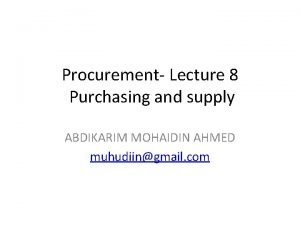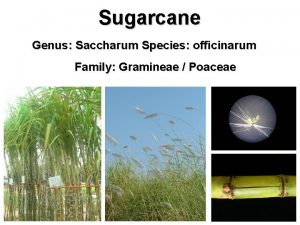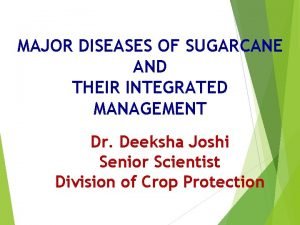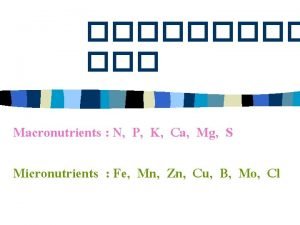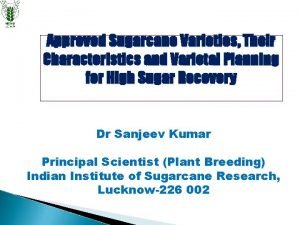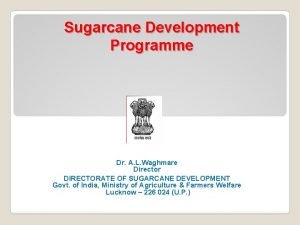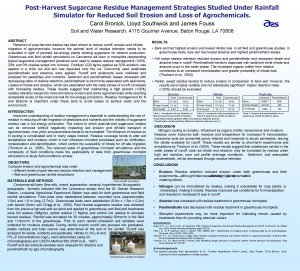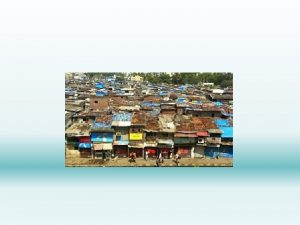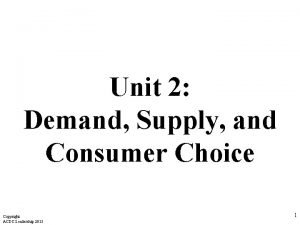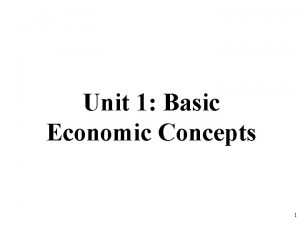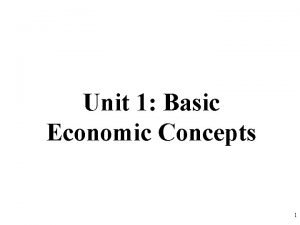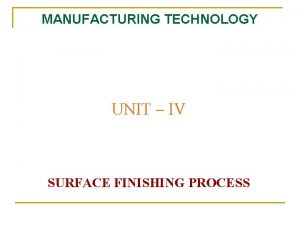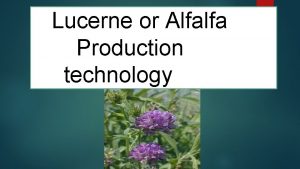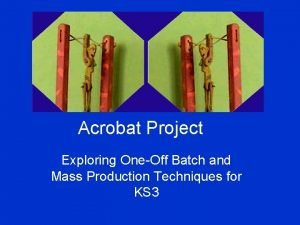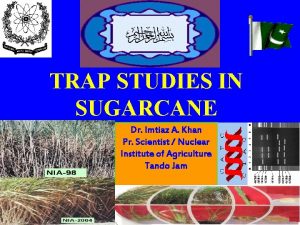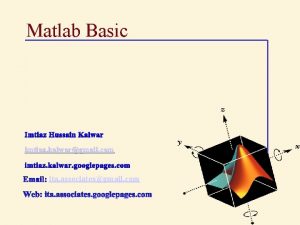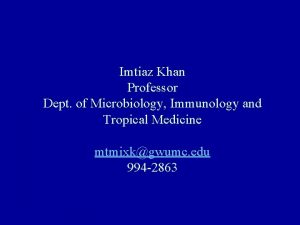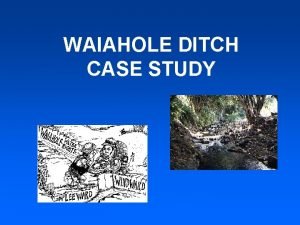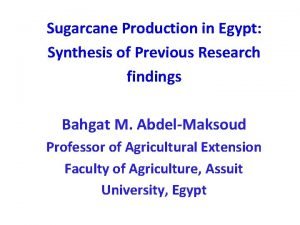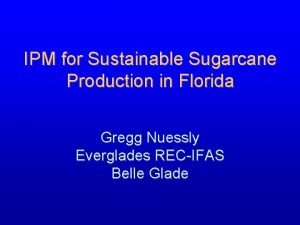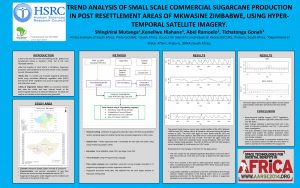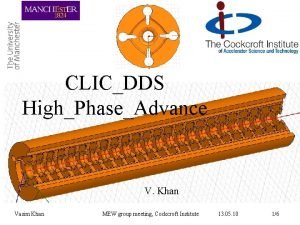Production Technology for Sugarcane Dr Imtiaz Ahmed Khan






































- Slides: 38

Production Technology for Sugarcane Dr. Imtiaz Ahmed Khan Deputy Chief Scientist (DCS) NIA, Tando Jam

Cane Yield (t/ha) Sugar Yield (t/ha) Cane & Sugar Yield Gap in Experimental and Farmer’s Field Expt. Highest Expt. Average Country Average

Causes of Low Cane Productivity § § § Varieties Land preparation Plant Population Agronomic practice Cane maturity Crop Protection

Complex natural material derived from disintegrated and decomposed rocks and organic material. Soil Mechanical Support Moisture Oxygen Nutrients

Tillage Practices § Decide based on previous cropping history, soil texture, locality and requirement of crop § Understand the role of tillage § Consider deep plowing every 3 -5 years based on prevailing crop rotations § Conservation § Use tillage vs conventional tillage wisdom, science and local experience § Consider cost effectiveness

Recommendation for plant population = 40, 000 double budded sets/ha One acre number of sets required 32300 What is happing in the field On Ave. a set size is one ft, So, 208 sets per row were planted 208 ft No. of rows in one acre 83 Therefore, 83 x 208 = 17264 208 ft This means that we have only 50% population

General Guidelines for Deficient and Sufficient Levels of Nutrients in Plants Elements N (%) P (%) K (%) Ca (%) Mg (%) S (%) Fe (mg/kg) Zn (mg/kg) Mn (mg/kg) Cu (mg/kg) B (mg/kg) Mo (mg/kg) Cl (%) William F. Bennett (1993) Deficient level < 2. 0 < 0. 2 < 1. 0 < 0. 1 < 50 15 -20 10 -20 3 -5 < 10 < 0. 1 < 0. 2 Sufficient range 2. 0– 5. 0 0. 2 -0. 5 1. 0 -5. 0 0. 1 -1. 0 0. 1 -0. 4 0. 1 -0. 3 50 -250 20 -100 20 -300 5 -20 10 -100 0. 1 -0. 5 0. 2 -2. 0

Fertilizer Application § Based on soil test, soil reaction/p. H § Concept of balanced fertilizer use § Previous cropping history § Organic amendments previously applied § Application § Use at critical stages of crop growth of suitable fertilizer application methods § Fertilizer application be followed by irrigation § Integrated plant nutrient management

PRICIPLES OF PLANT NUTRITION §Food is essential for survival man and other animal. §Likewise, plants require food for living, growth, development and yield formation 9

ESSENTIAL ELEMENTS OR PLANT NUTRIENTS §The plant nutrients are chemical elements, which are essential for normal growth and development for all plants. § However, in deeper sense the supply and absorption of chemical compounds needed for plant growth and metabolisms may be defined as nutrition and the chemical compounds required by the plant termed nutrient. 10

cont…. Forms absorbed Typical concentration in the plant dry matter Major elements/ Macro elements Nitrogen N Phosphorus P Potassium K Sulphur S Calcium Ca Magnesium Mg NH 4+, NO 3 H 2 PO 4 -, HPO 4 K+ SO 4 -Ca++ Mg++ 1 -5 % 0. 1 -0. 4% 1. 5% 0. 1 -0. 4% 0. 2 -0. 4% 0. 1 -0. 4% Micro nutrients/ Trace elements B Boron Iron Fe manganese Mn Copper Cu Zinc Zn Molybdenum Mo Chlorine Cl H 3 BO 3 -, H 2 BO 3 Fe++ Mn++ Cu++ Zn++ Mo. O 4 Cl- 6 -60 ppm 50 -250 ppm 20 -500 ppm 5 -20 ppm 25 -150 ppm Below 1 ppm 0. 2 -2 % Name Symbol 11

Classification of Plant Nutrients Used in large Used in small quantities (Micro/ Trace elements) (Major / Macro Nutrients) Primary Secondary N Ca P Mg K S Fe Zn Mn Cu Mo Cl B (Na, Si and Elements) 12 Co beneficial

Nutrient antagonism Zn, Mg, S, Fe, Mn Cu, B, Mo N P K 13

ROLE OF MAJOR NUTRIENTS IN PLANTS §Nitrogen -an indispensable elementary constituent of numerous organic compounds (amino acids, proteins, and enzymes). §It is a constituent of the chlorophyll and vigorous growth, branching/tailoring, leaf production and size enlargement. 14

Cont………. §Phosphorus §A constituent of several compounds including oils and amino acids. §It is essential for cell division, growth and lengthening of roots and fruit development and early ripening. §P-compounds (ADP, ATP) in fact as energy currency within the plant. 15

Cont……. §Potassium §It is a non-constituent nutrient in the plant. §It activates various enzyme pathways and involves photosynthesis and translocation of carbohydrates within the plant. §Potassium plays a significant role in the water economy of the plant 16

Occurrence of nutrient deficiencies in plants §Limitation of the plant nutrient in the soil. §Soil is rich in nutrients but present in a condition which uptake is impossible. e. g. P-fixation in soil. §Use of imbalanced fertilizer mixtures. eg. High Nfertilizer level will result deficiencies in P and K. §Growing same crop for a longer period (mono-cropping). Eg. Occurrence of Zinc deficiency. 17

FERTILIZER §Any substance that is added to soil to supply one or more plant nutrients and intended to increase plant growth and yield can be defines as a fertilizer. Aims of Fertilizer application: §To maintain the soil fertility §To increase the crop yield or higher returns from the crop i. e. higher profits. 18

Factors affecting fertilizer efficiency 1. Crop factors (Crop Spp, Age, and Nutrient removal): 2. Soil Factors (Nutrient Status of the soil, Soil p. H) 3. Climatic factors (Rain fed/Irrigated Agriculture 4. Economic factors a. Affordability (Socio economics standard of the farmer and the price of fertilizer, subsidized or not subsidized), b. Economic returns or profitability from fertilizer input used. 19

TIME OF APPLICATION (WHEN TO APPLY? ) Factors determine the time fertilizer applications are: 1. Moisture Availability in the soil 2. Rainfall pattern. Avoid peak monsoon period. Fertilizer can be applied either at the beginning of the monsoon or at the tail end of the monsoon. 3. Duration of the crop. Annual Perennial 20

METHODS OF APPLICATION (HOW TO APPLY? ) §Fertilizer should be applied to the active feeding root zone of the crop. §Not §If too close or too far from the base of the crop. it is too close to the base of the crop it can damage to the base of the crop and ultimate result will be killing the plant. 21

Factors Affecting Fertilizer Efficiency Poor Seedbed Preparation Delay in Sowing Inadequate Irrigation Weed Infestation Insect Attack Imbalanced Fertilizer Application 10 -25% 20 -40% 10 -20% 15 -50% 20 -50%

Causes of Deficiencies? v Soils’ Chemistry v Decreased Manure Use v Micronutrient Mining v Marginal Soils v High Yielding Varieties v Flooded Rice Soils v New Cultivars – More Susceptible v v Nutrient Antagonisms Micronutrient-free Fertilizers

Fertilizer Recommendations Crop Soil Texture Sugarcane Clay loam Fertilizer dose (N-P-K) kg/ha 200 -120 -150 For calcareous soils with alkaline p. H, use Ammonium sulphate, MAP, SOP For calcareous soils with normal p. H, use DAP, Urea, SOP

Irrigation Management §Source : canal or under ground water §Suitability based on laboratory analysis §Irrigation at critical stages of crop growth §Amount and method of application affects efficiency §Determine amounts based on water retention characteristics of soil: an area of extensive research in soil physics

Advanced Irrigation Practices § Soil water retention characteristics vary among different textural classes § Save water by applying amount that is needed to refill the soil up to field capacity § Monitoring changes in soil water is critical § Experience of developed nations can be used § Sensor technologies coupled with computer controlled irrigation offer great prospect

Environment § Biological § Soil and physical environment micro organisms can modify/improve BE § Organic amendments improve activity of soil microbes as they are rich in organic carbon § Earth worms make fine tunnels in soil : improve root penetration and aeration § Effective § Bio micro organism technology fertilizers to improve soil conditions

Remedy § Genotypes respond differently across a range of environments i. e. , the relative performance of varieties depends on the environment § Genotype by environment interactions are common for most quantitative traits of economic importance § Advanced breeding materials must be evaluated in multiple locations for more than three year (one plant and two ratoon crop)

Sustainable Sugarcane Production § § § § To grow early maturing, high cane and sugar yielding varieties. Initiate quality payment system Adoption of new production technology Apply alternate skip furrow irrigation Recovery schedule should be followed Fresh cane should be supplied to the sugar mills Supply of clean cane to the sugar mills Stoppage of water 20 -30 days before supply of cane to the sugar mills To avoid late application of fertilizer Development work should be under taken by the sugar mills Avoid late planting Recruitment of qualified cane staff by sugar mills Pre-sowing contract with the farmers to multiply high sugar varieties.

Cont. . Socioeconomic Aspects § Mostly small growers do not adopt innovations and lack resources to apply new technology due to which their yields are very low. § Big farmers responds to new innovations and have resources for their applications hence their yields are very high. Solutions § Provision of credit facilities to the small farmers. § Strengthening of linkage of Extension staff with the growers. § Availability of seed of approved varieties § High cost of inputs like seed, fertilizer, insecticide, diesel, equipment, irrigation water etc. should be rationalized.

Cont. . Marketing § Role of middle-man § Late payments by Sugar Mills to the cane growers § Less weighment of cane by Sugar Mills § High cost of production § Wait due to long queue’s Policies § Commencement of development activities by sugar mills. § Introduction of support price policy on quality payment. § Elimination of middle man Milling § Crushing of stalled cane. § Poor procurement system. § Non-adoption of harvesting schedule. § Recruitment of un-qualified staff. § Un-consistent policies.

Goal Oriented Efforts can Produce Desirable Results Sugar Mills Research Extension Farmers Integrated efforts of all the units can solve the problem

Emerging Challenge in Sugarcane White Leaf Disease § Sugarcane crop in Sindh province is being ruined by a devastating disease- the white leaf disease of sugarcane § Sugarcane white leaf disease- the most devastating disease of sugarcane- First recognized in Thailand (1954) § Extreme concerns highlighted by Habib sugar mills, and Mirpur Khas sugar mills § Caused by plant-pathogenic phytoplasma § Transmitted to the plant by leafhoppers Matsumuratettix hiroglyphicus and Yamatotettix flavovittatus 33

Sugarcane White Leaf Disease § Cream-colored or white stripes are formed parallel to the midribs § Stripes coalesce and extend along the entire leaf blades § Chlorosis; plant vigor decreases § Green islands with yellow/white background § Stunting and poor ratooning § Soft texture of plants § Slender, chlorotic shoots § No production of millable cane § 100% losses of certain areas of Thailand § Taiwan- controlled the disease through immediate measures 34

35

Possible Measures § Limited success § Chemotherapy § Thermotherapy § Establishment of disease-free nurseries § Rogueing of diseased plants § Resistant crop varieties 36

Food of Thought For developing sugarcane growing nations, there is still time for constructive and meaningful change. There is time to prepare its place as a future sugar crop, a domestic energy crop, and a multipleproducts commodity in service to all future generations. Alex G. Alexander

Thank you for your attention!
 Ahmed muhudiin ahmed
Ahmed muhudiin ahmed Sir syed ahmed khan father name
Sir syed ahmed khan father name Mohammedan anglo oriental defence association 1893
Mohammedan anglo oriental defence association 1893 Language translator
Language translator Tehzeeb ul akhlaq
Tehzeeb ul akhlaq Apa itu post production
Apa itu post production Poaceae grass
Poaceae grass Major disease of sugarcane is
Major disease of sugarcane is Sugarcane drip irrigation
Sugarcane drip irrigation Manganese deficiency in sugarcane
Manganese deficiency in sugarcane Sugarcane pith
Sugarcane pith Sugarcane juice story
Sugarcane juice story Economic importance of sugarcane
Economic importance of sugarcane Post harvest management of sugarcane
Post harvest management of sugarcane Tissue imtiaz dharker
Tissue imtiaz dharker Living space poem pdf
Living space poem pdf Identify how
Identify how Imtiaz munshi cpa
Imtiaz munshi cpa Living space imtiaz dharker analysis
Living space imtiaz dharker analysis Imtiaz alam md
Imtiaz alam md Living space poem
Living space poem New grilling technology cuts production time in half
New grilling technology cuts production time in half S&d analysis practice
S&d analysis practice Econmovies episode 5 worksheet answers
Econmovies episode 5 worksheet answers Maize production technology
Maize production technology Surface finishing operations in production technology
Surface finishing operations in production technology Lucerne common name
Lucerne common name Mass production technology
Mass production technology Formuö
Formuö Novell typiska drag
Novell typiska drag Nationell inriktning för artificiell intelligens
Nationell inriktning för artificiell intelligens Returpilarna
Returpilarna Shingelfrisyren
Shingelfrisyren En lathund för arbete med kontinuitetshantering
En lathund för arbete med kontinuitetshantering Adressändring ideell förening
Adressändring ideell förening Personlig tidbok
Personlig tidbok A gastrica
A gastrica Densitet vatten
Densitet vatten Datorkunskap för nybörjare
Datorkunskap för nybörjare
